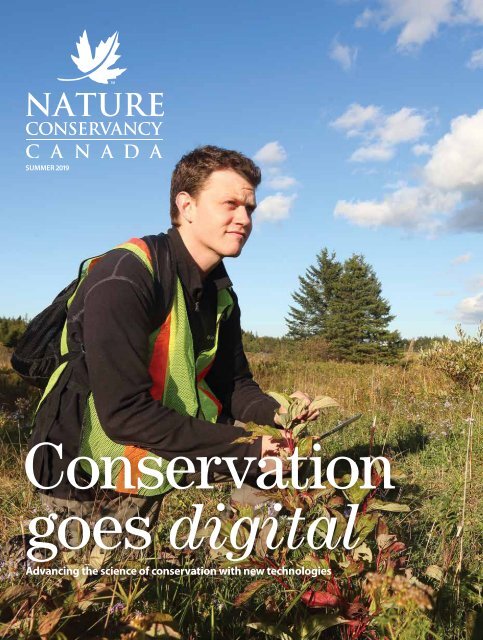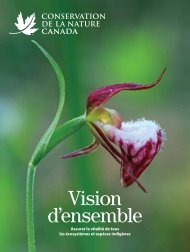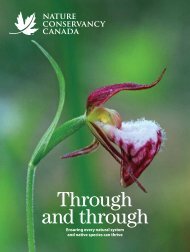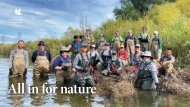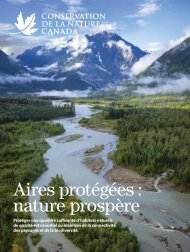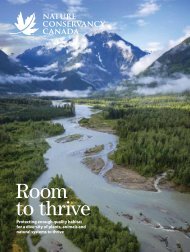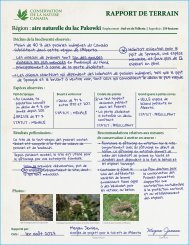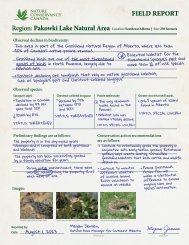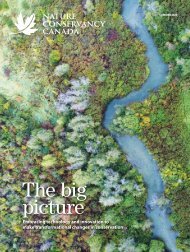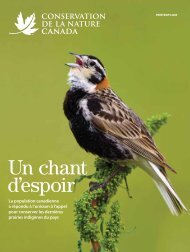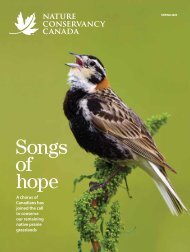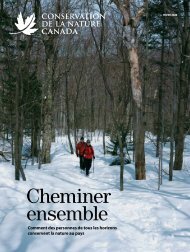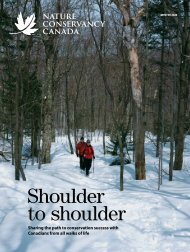NCC Magazine, Summer 2019
You also want an ePaper? Increase the reach of your titles
YUMPU automatically turns print PDFs into web optimized ePapers that Google loves.
SUMMER <strong>2019</strong><br />
Conservation<br />
goes digital<br />
Advancing the science of conservation with new technologies
Nature Conservancy of Canada<br />
245 Eglinton Ave. East, Suite 410<br />
Toronto, Ontario, Canada M4P 3J1<br />
magazine@natureconservancy.ca<br />
Phone: 416.932.3202<br />
Toll-free: 877.231.3552<br />
The Nature Conservancy of Canada<br />
(<strong>NCC</strong>) is the nation’s leading land<br />
conservation organization, working<br />
to protect our most important natural<br />
areas and the species they sustain.<br />
Since 1962, <strong>NCC</strong> and its partners have<br />
helped to protect 2.8 million acres<br />
(more than 1.1 million hectares),<br />
coast to coast.<br />
The Nature Conservancy of Canada<br />
<strong>Magazine</strong> is distributed to donors and<br />
supporters of <strong>NCC</strong>.<br />
TM<br />
Trademarks owned by the Nature<br />
Conservancy of Canada.<br />
FSC is not responsible<br />
for any calculations on<br />
saving resources by<br />
choosing this paper.<br />
Printed on Rolland Opaque paper,<br />
which contains 30% post-consumer<br />
fibre, is EcoLogo, Processed Chlorine<br />
Free certified and manufactured in<br />
Canada by Rolland using biogas energy.<br />
Printed in Canada with vegetable-based<br />
inks by Warrens Waterless Printing.<br />
This publication saved 29 trees and<br />
104,292 litres of water*.<br />
COVER<br />
Adam Cheeseman monitors the Chignecto<br />
Isthmus for WildPaths Maritimes.<br />
Photo by Mike Dembeck.<br />
THIS PAGE<br />
Chignecto Isthmus, NB.<br />
Photo by Mike Dembeck.<br />
TKTKTKTKTKTKT<br />
GENERATED BY: CALCULATEUR.ROLLANDINC.COM<br />
*<br />
2 SPRING <strong>2019</strong> natureconservancy.ca
SUMMER <strong>2019</strong><br />
CONTENTS<br />
Nature Conservancy of Canada<br />
Dear Friend,<br />
TKTKTKTKTKTKT<br />
If you’re reading this magazine, there’s a strong<br />
chance that you already feel quite connected to<br />
nature. You might have a favourite neighbourhood<br />
tree, spend most weekends outdoors and<br />
consider hiking boots a fashion accessory.<br />
But a recent survey, released by the Nature<br />
Conservancy of Canada (<strong>NCC</strong>) in partnership<br />
with Ipsos Public Affairs, reveals a growing<br />
disconnect between Canadians and nature.<br />
Canadians say they feel happier, healthier<br />
and more productive when they are connected<br />
to nature. Yet you might be surprised to<br />
find out that 74 per cent say that it is simply<br />
easier to spend time indoors and 66 per cent<br />
say they spend less time in nature today<br />
than in their youth.<br />
That’s why this summer, <strong>NCC</strong> is offering<br />
you a number of ways to strengthen your connection<br />
to nature. Our Nature Score program<br />
(page 4) launches this month. It offers you<br />
the opportunity to test your level of connectedness<br />
with nature. You’ll then be matched up<br />
with a Nature Coach, who’ll send you weekly<br />
tips to help improve your score.<br />
Our feature story is about the many ways<br />
that technology can help connect you with nature<br />
and conservation through citizen science<br />
apps such as iNaturalist or eBird. Once you<br />
download the apps, why not document the<br />
species you encounter when you visit one of<br />
our close to 40 Nature Destinations across the<br />
country, and upload your observations? Nature<br />
Destinations have been specially chosen to<br />
offer you memorable experiences in some of<br />
Canada’s most stunning landscapes, such as<br />
the unique Nodwell Property in Alberta’s<br />
Badlands (page 6).<br />
As always, thank you for your support of<br />
the Nature Conservancy of Canada. No matter<br />
how you choose to connect with nature,<br />
I hope your summer is filled with memorable<br />
experiences and adventures.<br />
CBT<br />
Christine Beevis Trickett,<br />
Director, Editorial Services<br />
natureconservancy.ca<br />
8<br />
14 16<br />
14 What’s your Nature Score?<br />
Take the quiz and find out how connected you are to the natural world<br />
6 Step back in time<br />
Take a trip through 70 million years of our planet’s ecological history when<br />
you visit this site near Drumheller, Alberta<br />
7 A caring nature<br />
<strong>NCC</strong> monthly donor Bill Armstrong is always happy to help nature as<br />
a Conservation Volunteer<br />
8 There’s an app for that<br />
New technologies like the iNaturalist app are empowering nature lovers<br />
across Canada to contribute to the science of conservation<br />
12 Western bluebird<br />
Known as the harbinger of spring, the western bluebird’s song can be heard<br />
as the weather warms and wildflowers start blooming in western Canada<br />
14 Project updates<br />
Expanding a coastal haven for birds in Nova Scotia; Alvar research in Manitoba;<br />
Using citizen science in Quebec; Natural Heritage Conservation Program<br />
16 A natural enthusiasm<br />
After 20 years of volunteering with <strong>NCC</strong>, Bruce MacLellan, chair of <strong>NCC</strong>’s<br />
national board, is just as excited about conservation as when he first started<br />
18 Working for nature<br />
Two different, yet equally wonderful, internship experiences with <strong>NCC</strong><br />
SUMMER <strong>2019</strong> 3
COAST TO<br />
COAST<br />
What’s your<br />
Nature Score?<br />
Take the quiz and find out how connected<br />
you are to the natural world<br />
This summer, the Nature Conservancy of Canada<br />
(<strong>NCC</strong>) is launching Nature Score, a program that<br />
lets you discover how connected you are to nature.<br />
The program draws on the research of Lisa Nisbet, associate<br />
professor in the psychology department at Trent University,<br />
in Ontario. Being connected to nature isn’t just<br />
about a love of nature; it’s about understanding our interdependence<br />
with the natural world and the importance of<br />
all aspects of nature, not just the beautiful or useful parts.<br />
Have we piqued your curiosity? Great! To determine<br />
your Nature Score, you’ll be asked to answer a short quiz,<br />
which is based on a more extensive questionnaire originally<br />
developed by Nisbet and her colleagues. Once you receive<br />
your score, you’ll be assigned a friendly virtual Nature<br />
Coach. The coach will help you to improve your score with<br />
tips in weekly emails.<br />
According to some theorists, humans are born with an<br />
innate connection to nature. But this connection must be<br />
nurtured. “The need to encourage Canadians to enhance<br />
their relationships with nature has never been as urgent<br />
as it is today,” says Erica Thompson, senior director of<br />
engagement for the Nature Conservancy of Canada. “Today,<br />
many children are growing up without having experiences<br />
in nature. Researchers are finding that they may<br />
be less likely to care about nature in the same way as previous<br />
generations.”<br />
If we want to conserve more natural places faster,<br />
people must be aware of the benefits of conservation, not<br />
only for nature but also for themselves. Which brings us<br />
back to Nature Score. “By encouraging more people to<br />
improve their Nature Score and deepen their connection<br />
to nature, we believe we will have a better chance of<br />
improving their understanding of nature’s benefits,”<br />
says Thompson.<br />
ISTOCK<br />
FIND YOUR<br />
NATURE SCORE!<br />
Visit naturequiz.ca today.<br />
TKTKTKTKTKTKT<br />
4 SUMMER <strong>2019</strong> natureconservancy.ca
Here’s a little refresh of the benefits<br />
you’ll glean from spending time in nature:<br />
1<br />
1. Good for your body<br />
Spending time in nature has health benefits that<br />
go beyond physical activity. Take spending time<br />
in forests, for example. When you’re immersed in<br />
the woods, you inhale the trees’ natural chemical<br />
compounds. That’s not just the scent of pine or the<br />
aroma of cottonwoods. These compounds have been<br />
shown to reduce blood pressure and make you feel<br />
calmer and more relaxed. Being in nature can also<br />
positively affect the healthy bacteria and other microflora<br />
living in your gut, which can help boost your<br />
immunity to certain diseases. The more time you<br />
spend in nature, the more diverse your microflora.<br />
2<br />
2. Good for your mind<br />
Better memory? Better concentration? Count us in!<br />
Being in nature can positively affect your mental<br />
faculties. A walk in nature, for example, could improve<br />
your short-term memory. A University of Michigan<br />
study found that participants who walked around an<br />
arboretum and repeated a memory test performed<br />
almost 20 per cent better on it than they had initially<br />
when they took the test indoors. Time in nature can<br />
also improve your ability to focus. In fact, children diagnosed<br />
with ADHD have been shown to concentrate<br />
better after spending only 20 minutes in a park.<br />
4<br />
3<br />
5<br />
3. Improves your mental health<br />
Do you feel happier when you’re in the great<br />
outdoors? You’re not alone. People who take part<br />
in nature-based activities tend to be happier than<br />
those who do not. As well, a strong connection to<br />
nature tends to lead to high levels of self-esteem,<br />
well-being and personal growth. Being in nature is<br />
also linked to fewer symptoms of mental health disorders.<br />
Spending time outside can also reduce stress<br />
and anxiety. It’s hard to argue with the evidence!<br />
4. Promotes positive<br />
social behaviours<br />
Spend time in nature and you’re likely to foster<br />
positive social behaviours like altruism, kindness,<br />
generosity and resource-sharing. And that’s a wonderful<br />
thing. Just seeing beautiful nature scenes can<br />
make you more cooperative and generous toward<br />
others, even strangers. It can also elicit feelings of<br />
awe and encourage you to solve problems in more<br />
cooperative and creative ways.<br />
ADELA KANG.<br />
5. Inspires support for conservation<br />
Your connection to nature can be correlated to a positive<br />
attitude towards conservation. If, while growing<br />
up, you had positive, direct experiences in nature and<br />
close role models who cared about it, you’re more likely<br />
to support the places you care about as an adult.1<br />
natureconservancy.ca<br />
SUMMER <strong>2019</strong> 5
BOOTS ON<br />
THE TRAIL<br />
Step back in time<br />
Take a trip through 70 million years of our planet’s ecological<br />
history when you visit this site near Drumheller, Alberta<br />
Mountain bluebird<br />
Ajourney into Horseshoe Canyon is a<br />
journey back in time. The canyon is<br />
an isolated pocket of badlands amidst<br />
the Alberta prairie, 17 kilometres west of Drumheller<br />
on Highway 9. Horseshoe Canyon is a<br />
familiar vista to many Albertans and a favourite<br />
spot for tourists to catch their first glimpse of<br />
this unique aspect of Alberta’s natural heritage.<br />
The canyon represents three distinct habitats:<br />
prairie, wooded coulee slopes and badlands.<br />
The geological layers were laid during<br />
the late Cretaceous period some 70 million<br />
years ago, when dinosaurs roamed the lush<br />
forests and swamps of the region. These layers<br />
can now be seen on the exposed walls of<br />
Horseshoe Canyon.<br />
The Nature Conservancy of Canada’s<br />
(<strong>NCC</strong>’s) Nodwell property encompasses<br />
a portion of Horseshoe Canyon. <strong>NCC</strong> has collaborated<br />
with local landowners to ensure<br />
the long-term conservation of this distinctive<br />
canyon, which is one of the best-known sites<br />
in the Canadian Badlands.<br />
The geological features of the property,<br />
made visible through erosion, exposes our<br />
planet’s history, and contains information<br />
about past plant and animal life as well as<br />
human history.<br />
Start your journey in the prairie grasslands<br />
on the trail along the canyon edge.<br />
Follow it through the wooded coulee slopes<br />
and into the canyon badlands. While in the<br />
canyon, observe the erosion features, such<br />
as rills (channels made by small streams)<br />
on the coulee slopes and hoodoos (rock<br />
columns formed by erosion). This is truly<br />
a unique place.<br />
HABITAT<br />
Prairie grasses, once the nourishment of vast<br />
herds of plains bison, can still be found on<br />
the Nodwell property, along coulee edges, on<br />
top of mesas and on the valley floor. These<br />
grasses are well adapted to drought, wildfires<br />
and grazing.<br />
North-facing slopes of the coulees areshaded<br />
from the sun’s searing summer heat.<br />
In contrast to the sun-exposed slopes,<br />
ROBERT BERDAN. INSET: JOHN E. MARRIOTT.<br />
6 SUMMER <strong>2019</strong><br />
natureconservancy.ca
SPECIES TO SPOT<br />
• American pasqueflower<br />
• American silverberry<br />
• black-capped chickadee<br />
• Canada buffaloberry<br />
• creeping juniper<br />
• mountain bluebird<br />
• mule deer<br />
• pincushion cactus<br />
• plains gartersnake<br />
• prairie sagebrush<br />
• prickly pear cactus<br />
• prickly rose<br />
• purple prairie-clover<br />
• red-tailed hawk<br />
• Richardson’s ground squirrel<br />
• rough fescue<br />
• Saskatoon serviceberry<br />
• scarlet globemallow<br />
• slender wheatgrass<br />
• western porcupine grass<br />
• white spruce<br />
• winter-fat<br />
BACKPACK<br />
ESSENTIALS<br />
A caring nature<br />
<strong>NCC</strong> monthly donor Bill Armstrong is always happy to help<br />
nature as one of <strong>NCC</strong>’s Conservation Volunteers<br />
Prickly pear cactus<br />
shaded areas feature lush growth that includes<br />
white spruce, prickly rose and Saskatoon<br />
serviceberry.<br />
Plants and animals found in Horseshoe Canyon<br />
have adapted to the harsh environment<br />
of the badlands. American pasqueflower can<br />
be found here, as well as several species of<br />
sage, mountain bluebird, gartersnake, mule<br />
deer and more.<br />
SEASONS<br />
Accessible year-round.<br />
One item I always take — wear,<br />
actually — to a Conservation<br />
Volunteers (CV) event is my<br />
Unpaid Intern T-shirt. I’ve found that the<br />
shirt elicits a chuckle or two; a way of loosening<br />
things up with the other volunteers,<br />
many of whom I’ve not met before.<br />
One of the things I enjoy most about<br />
CV events is meeting the real (paid) interns<br />
working for the Nature Conservancy of Canada<br />
(<strong>NCC</strong>) for the summer. These young<br />
people are studying subjects that likely didn’t<br />
exist when I attended university, and it’s a<br />
tonic to hear about their love of nature and<br />
their determination to contribute to nature<br />
conservation through their chosen field of<br />
study. It gives me hope knowing that the<br />
names of these interns will pop up again in<br />
the future, either as full-time <strong>NCC</strong> staffers,<br />
or in other positions where they are making<br />
a difference for nature.1<br />
Become an intern!<br />
Learn about our paid Conservation Internship<br />
Program at conservationinterns.ca.<br />
ROBERT BERDAN. T-SHIRT: JUAN LUNA.<br />
TRAILS<br />
The property offers a number of trails that<br />
wind through its unique geologic formations.<br />
• Interpretive loop<br />
Type: Loop Difficulty: Easy<br />
Surface: Earthen<br />
Round-trip distance: 700 m<br />
• Canyon-bottom trails<br />
Type: Linear Difficulty: Moderate<br />
Surface: Earthen<br />
Round-trip distance: 4 km<br />
(includes interpretive loop)<br />
• Trail leading into canyon<br />
Type: Linear Difficulty: Moderate<br />
Surface: Earthen<br />
Round-trip distance: 400 m1<br />
Learn more!<br />
Discover this property and more of <strong>NCC</strong>’s<br />
Nature Destinations at naturedestinations.ca<br />
natureconservancy.ca<br />
SUMMER <strong>2019</strong> 7
Volunteer Adam Cheeseman<br />
in the field, near Sackville,<br />
New Brunswick<br />
8 SUMMER <strong>2019</strong> natureconservancy.ca
There’s an<br />
app for that<br />
New technologies, like the iNaturalist app, are empowering nature lovers<br />
across Canada to contribute to the science of conservation<br />
BY Deborah Carr, author and freelance writer<br />
MIKE DEMBECK<br />
dam Cheeseman scans the<br />
gravel shoulders as I navigate<br />
a country highway just outside<br />
of Sackville, New Brunswick.<br />
I’m appreciating the treebordered<br />
fields, quaint homesteads and bales<br />
of fresh-cropped hay. He’s looking for roadkill.<br />
“It’s pretty common to find a raccoon or<br />
porcupine along this stretch,” he says. “I’m<br />
surprised we haven’t seen one yet. Pull over<br />
and we’ll walk a bit so I can check the ditches.”<br />
I ease the car well off the pavement and<br />
park. Cheeseman climbs out, pulls a bright yellow<br />
safety vest from the trunk and slides it on.<br />
“Safety first,” he says, snapping the enclosures.<br />
Then, tablet in hand, he ambles along the shoulder,<br />
peering into the long grass at the roadside.<br />
Roadside reconnaissance wasn’t something<br />
he pictured himself doing while studying for<br />
his master’s of environmental studies at Dalhousie<br />
University. But here he is. Monitoring<br />
this stretch has been part of Cheeseman’s<br />
routine twice a month, from spring to fall,<br />
since he started volunteering with the Nature<br />
Conservancy of Canada’s (<strong>NCC</strong>’s) WildPaths<br />
Maritimes project last year. He regularly<br />
travels this route to visit family along the<br />
Northumberland Strait.<br />
natureconservancy.ca<br />
SUMMER <strong>2019</strong> 9
L to R: Viceroy butterfly; iNaturalist app; Chignecto Isthmus<br />
region; Adam Cheeseman in the field.<br />
Knowledge is power<br />
WildPaths Maritimes depends upon help from<br />
volunteers like Cheeseman, who regularly<br />
cruise highways in southeastern New Brunswick<br />
and record wildlife sightings (dead or<br />
alive) on a powerful mobile application called<br />
iNaturalist. The ultimate goal of the project<br />
is to identify roads within the Chignecto<br />
Isthmus region — a narrow neck of land connecting<br />
New Brunswick and Nova Scotia —<br />
that present the greatest barriers and dangers<br />
to wildlife movement. Then scientists can<br />
work to find safer solutions for both animals<br />
and people.<br />
“The isthmus is a critical linkage for a variety<br />
of animals,” says <strong>NCC</strong>’s New Brunswick<br />
program director, Paula Noel. “Its geography<br />
makes it a natural bottleneck for wildlife. However<br />
it’s now even more constrained because<br />
of roads, housing developments, agriculture<br />
and forestry.” Noel adds that if scientists can<br />
determine the areas where animals are most<br />
likely crossing highways, then mitigation tools,<br />
such as culverts or fencing, can be installed.<br />
“This will make it safer for the animals, and the<br />
people who are driving along this section of<br />
road. This is where volunteers and iNaturalist<br />
play a crucial role,” she explains. Noel adds<br />
that the information the volunteers gather will<br />
be provided to the provincial transportation<br />
department. This can help identify where<br />
there are problems. In some cases <strong>NCC</strong> can<br />
protect habitat and work with the province<br />
to find ways to mitigate these problems.<br />
Beyond the value of the isthmus as a natural<br />
wildlife corridor, the Moncton/Dieppe/Shediac<br />
region, to the west of the isthmus, is of particular<br />
interest because it’s the fastest growing<br />
community in Atlantic Canada. A growing<br />
economy means more urban expansion into<br />
outlying areas. <strong>NCC</strong> wants to ensure future<br />
development plans recognize the importance<br />
of conserving areas for the movement of wildlife.<br />
Should the habitat connectivity of the isthmus<br />
be lost, many of Nova Scotia’s wildlife species,<br />
such as moose, would become landlocked.<br />
This could reduce their genetic diversity.<br />
“But we have a chance to make a difference<br />
now,” says Noel. “While there’s still habitat,<br />
there’s a chance to build a network of protected<br />
areas. Solid scientific data, such as the<br />
information Cheeseman is collecting, helps<br />
inform smart road design and land-use planning.<br />
This helps wildlife safely cross roads.”<br />
WildPaths Maritimes, which was modelled<br />
after WildPaths Vermont, is part of the larger,<br />
international Staying Connected Initiative<br />
(SCI). SCI is a coalition of organizations in<br />
northeastern U.S. and southeastern Canada<br />
looking to protect wildlife corridors. SCI partners<br />
in Quebec (including <strong>NCC</strong>) manage two<br />
projects: carapace.ca, which collects data on<br />
turtles along roadways, and Stop Carcasses,<br />
which also looks for hot spots where wildlife<br />
cross roads. All of these projects can be found<br />
on iNaturalist, and anyone can join and contribute<br />
data to them.<br />
“The data collection work becomes particularly<br />
important as our climate changes,<br />
causing habitats to shift,” notes Noel. “We’re<br />
already seeing new species moving beyond<br />
their historic northern range.”<br />
Global contributions<br />
Within only a few dozen metres, Cheeseman<br />
spies a game trail curving through the long<br />
grass. Clearly, a small animal has been crossing<br />
the highway here on a regular basis. On the<br />
opposite side of the road, where the trail<br />
continues into the woods, he points out<br />
a small pile of coyote scat.<br />
“Until I began doing this, I didn’t appreciate<br />
how active roadways really are,” he says. “Now,<br />
I think more from the animal’s perspective.<br />
Imagine how difficult it must be to get across…<br />
The noise, the speed of the cars, the smells. So<br />
many sensory distractions to take in just trying<br />
to cross this single spread of asphalt. We forget<br />
what kind of impact we have.”<br />
Cheeseman has mostly found evidence of<br />
small- to medium-sized mammals, but he’s also<br />
seen deer disappearing into the woods, moose<br />
tracks and droppings, along with a variety of<br />
amphibians, insects and birds that didn’t survive<br />
the crossing.<br />
Ahead, a splash of colour catches his eye,<br />
and he bends to inspect a dead butterfly.<br />
Using the iNaturalist app on his tablet, he<br />
snaps a photograph. The app automatically<br />
records the date and GPS location, then compares<br />
Cheeseman’s photo to its database. It<br />
responds with a list of suggestions that help<br />
him identify the butterfly as a viceroy. He<br />
saves the record and flags the observation<br />
for the WildPaths Maritimes project, which<br />
separates out the sightings within this specific<br />
geographic area, while including them in<br />
the global iNaturalist database. His work has<br />
importance far beyond this region.<br />
When first uploaded, an observation is<br />
classified as “casual,” but once verified by two<br />
other experts, it’s re-classified as “research<br />
grade.” The record may now be used by important<br />
databases like the Atlantic Canada<br />
Conservation Data Centre and Global Biodiversity<br />
Information Facility system. With<br />
a few clicks, Cheeseman’s viceroy observation<br />
is now part of a database used by scientists<br />
around the world. Once reserved for museum<br />
expeditions and scientists, new and interesting<br />
species observations can now be recorded<br />
by anyone with a smartphone.<br />
This is, by far, the coolest part of the program.<br />
There are currently more than 26,000<br />
people using iNaturalist in Canada and about<br />
1 million observations of 18,000 different<br />
species since its launch in 2015. These contribute<br />
to the global database, which has<br />
15 million verifiable observations.<br />
ISTOCK. INATURALIST.<br />
10 SUMMER <strong>2019</strong> natureconservancy.ca
MIKE DEMBECK.<br />
These apps create opportunities for us to connect<br />
with nature in a way we haven’t been able to before,<br />
with meaningful outcomes for conservation.<br />
A world to discover<br />
“Because of these citizen scientist observations,<br />
we’re seeing reports of species not previously<br />
found within the region,” says James<br />
Pagé, species at risk and biodiversity specialist<br />
with the Canadian Wildlife Federation. “So,<br />
we can ask, did they actually move north, or<br />
is it climate change, or just because people<br />
are now reporting them?”<br />
Pagé helped create the Canadian version of<br />
the original iNaturalist application, working<br />
with Parks Canada, the Royal Ontario Museum<br />
and NatureServe Canada to create a database<br />
catering to Canada’s northern species.<br />
Thanks to smartphones and apps, science<br />
is no longer solely within the purview of academics.<br />
Citizen observations are important<br />
because they often occur outside areas normally<br />
covered by the scientific community.<br />
“No matter how good they are, your experts<br />
can’t be everywhere,” Pagé points out. “But<br />
with all their outdoor activities, citizen scientists<br />
can cover a lot more ground.”<br />
There are still many places, even in southern<br />
Canada, that have not been inventoried for<br />
plants and animals. Now anyone can provide<br />
important observations that can help inform<br />
decisions on everything from status assessment<br />
of species to park management plans.<br />
“This opens up a whole world of discovery,”<br />
says Dan Kraus, <strong>NCC</strong>’s senior conservation<br />
biologist. “You can easily see where no<br />
one has entered iNaturalist records, then fill<br />
in that little blank spot in our nature knowledge.<br />
When you have thousands doing that,<br />
you have this incredible amount of new information<br />
that can be used in new ways to protect<br />
nature.”<br />
As citizens are recording their observations<br />
on iNaturalist, researchers around the<br />
world are accessing the verified data. They’re<br />
finding new ranges, trends and population<br />
status information, including data for species<br />
at risk. Several publications in peer-reviewed<br />
journals now contain data from iNaturalist.<br />
“The great thing about this technology is<br />
that anyone who wants to contribute to nature<br />
and conservation can do so in a meaningful<br />
way,” says Kraus. “This data provides us<br />
with new insights on how species are distributed<br />
and how they’re using the landscape.<br />
Most importantly from <strong>NCC</strong>’s perspective, the<br />
data helps provide information on what the<br />
species’ conservation needs may be.”<br />
iNaturalist has already led to the discovery<br />
of new species in Canada. When biologist Colin<br />
Jones recorded a crayfish in iNaturalist, other<br />
experts confirmed it was a paintedhand mudbug;<br />
a new species for Canada. “People might<br />
have seen it before,” says Kraus, “but they’d<br />
never had access to an expert that helped<br />
identify it, through their smartphone.”<br />
In this way, technology supports learning by<br />
helping people identify species more quickly,<br />
no matter whether they are on home ground<br />
or travelling. Birders and naturalists also cite<br />
the convenience of the app in that they no<br />
longer need to travel with bulky field guides<br />
and notebooks. Their recorded sightings are<br />
also accessible to peers and scientists. iNaturalist<br />
even has an app for children, called Seek,<br />
that doesn’t require personal information.<br />
“Those who work in conservation are<br />
often concerned that technology will distance<br />
us from nature,” says Kraus.“But these apps<br />
create opportunities for us to connect with<br />
nature in a way we haven’t been able to before.<br />
Now, we can all participate in informationsharing<br />
that has meaningful outcomes<br />
in conservation.”<br />
Back on the highway, Cheeseman places<br />
the viceroy back on the ground. “One day,<br />
within 100 to 200 metres, I found three different<br />
species of butterfly.” He stands and gazes<br />
across a field of asters and fireweed gone to<br />
seed. “When you’re driving, you don’t think<br />
about the smaller species you interact with…<br />
About the incredible diversity of life that<br />
exists along our roadways.”<br />
He turns back towards the car. “There’s<br />
really so much we don’t think about, isn’t<br />
there? Until we slow down and get outside.”1<br />
CITIZEN SCIENCE<br />
You can help <strong>NCC</strong>’s efforts by<br />
submitting sightings to the eBird<br />
and iNaturalist programs<br />
Although <strong>NCC</strong> has fantastic staff,<br />
they can’t quite manage to be<br />
everywhere all of the time. Visitors<br />
to <strong>NCC</strong> properties and surrounding<br />
areas can be incredibly helpful to<br />
building our knowledge of properties<br />
and natural areas by submitting<br />
their wildlife, plant and fungi sightings<br />
to iNaturalist. Bird observations can<br />
also be submitted to the eBird app.<br />
<strong>NCC</strong> science and stewardship staff<br />
can look up these sightings and use<br />
the information to learn more about<br />
what species occur in the area.<br />
Over time, the amount of data<br />
being amassed via citizen science<br />
is giving us (<strong>NCC</strong>, and scientists<br />
worldwide) an unprecedented<br />
understanding of population size,<br />
distribution and the timing of<br />
migration, nesting and flowering<br />
of both common and rare species.<br />
This information will be incorporated<br />
into our property and landscapescale<br />
planning over time. This will<br />
help ensure that we’re managing<br />
our properties to protect rare and<br />
declining species and their habitats.<br />
We can also use citizen science data<br />
to better understand the needs of<br />
visitors to our properties. For example,<br />
over time, <strong>NCC</strong> staff hope to be able<br />
to gauge which trails people use the<br />
most, and at what time of the year,<br />
in part from citizen science data. This<br />
will help us allocate our resources to<br />
maintaining and enhancing trails and<br />
other visitor management infrastructure<br />
efficiently and strategically.<br />
Deborah Carr is a New Brunswick<br />
freelance writer and author of the<br />
biography, Sanctuary: The Story<br />
of Naturalist Mary Majka.<br />
natureconservancy.ca<br />
SUMMER <strong>2019</strong> 11
SPECIES<br />
PROFILE<br />
Western<br />
bluebird<br />
(Coastal population)<br />
Known as the harbinger of spring, the<br />
western bluebird’s subtle song can be<br />
heard as the weather warms and wildflowers<br />
start blooming in western Canada<br />
TIM ZUROWSKI.<br />
12 SUMMER <strong>2019</strong><br />
natureconservancy.ca
SIZE AND APPEARANCE<br />
A member of the thrush family, the western bluebird<br />
has a bright blue head and wings, with a rust-orange<br />
front that often extends onto its back. Males are larger<br />
and brighter than the greyish-brown females.<br />
RANGE<br />
The western bluebird ranges from BC and Alberta,<br />
through the western U.S. into southcentral Mexico. Six<br />
sub-species have been identified, two of which occur in<br />
Canada. The coastal population occurs in the Salish Sea<br />
region of southwestern BC and western Washington. In<br />
early fall, these short-distance migrators fly to wintering<br />
grounds in Oregon, California and Mexico. They return<br />
in late February and March and are among the first<br />
migratory birds to re-appear each spring.<br />
CAVITY NESTERS<br />
These songbirds are cavity nesters, meaning they find<br />
nesting sites in the holes of living or dead trees. Because<br />
they can’t create their own holes, they depend on<br />
naturally occurring cavities, old woodpecker nests or<br />
bird houses.<br />
Bringing back the bluebirds<br />
Western bluebirds were once common on Vancouver<br />
Island and the Gulf Islands, but they had all but disappeared<br />
from the region by 1995. Their decline was probably due<br />
to a combination of Garry oak habitat loss, the removal of<br />
dead standing trees that provide nesting cavities and the<br />
competition for nest holes with introduced European<br />
starlings and house sparrows.<br />
Inspired by the success of a western bluebird reintroduction<br />
project in the nearby San Juan Islands in Washington<br />
State, the Garry Oak Ecosystems Recovery Team (GOERT)<br />
established the Bring Back the Bluebirds Project in 2011.<br />
The goal was to re-establish a breeding western bluebird<br />
population on southeastern Vancouver Island and the<br />
southern Gulf Islands by installing nest boxes in suitable<br />
habitat and through translocation (i.e., capturing, transporting<br />
and releasing birds from one area to another).<br />
In 2012, the Nature Conservancy of Canada (<strong>NCC</strong>) joined<br />
GOERT, the Cowichan Valley Naturalists Society (CVNS),<br />
Ecostudies Institute (Washington) and the Province of<br />
British Columbia in efforts to reintroduce western bluebirds<br />
to the Cowichan Valley. From 2012 through 2016, 56 adults<br />
and 64 nestlings were translocated from the closest healthy<br />
population in Washington State. <strong>NCC</strong>’s Cowichan Garry Oak<br />
Preserve in Duncan, BC, was the first release site.<br />
Since 2017, CVNS has coordinated this conservation effort.<br />
Through community engagement and volunteers’ hard work,<br />
CVNS is ensuring that the network of over 200 nest boxes on<br />
nearly 70 private properties continues to provide nesting<br />
sites for western bluebirds and other native cavity nesters.<br />
PERCHING PREDATORS<br />
These petite predators perch on low branches, fences and<br />
shrubs. Here, they scan the ground for insects to eat, and<br />
then drop to the ground when they have spotted one.<br />
These birds prefer large, open areas with low grasses so<br />
they can easily see ground-dwelling insects.<br />
Cowichan Garry Oak Preserve<br />
<strong>NCC</strong><br />
GARRY OAK<br />
The coastal population of western bluebird occurs in<br />
open woodlands, such as Garry oak savannahs. Today, less<br />
than five per cent of these habitats remain in Canada,<br />
making this one of Canada’s most endangered ecosystems.<br />
HELP OUT<br />
You can help the western bluebird. To find out how, visit<br />
giftsofnature.ca.<br />
A precarious success<br />
Translocations of this migratory species have been successful,<br />
with more adults returning each spring to Vancouver Island<br />
and the San Juan Islands and some birds moving between<br />
the two states. However, the small population remains<br />
vulnerable. More translocations may be required to secure<br />
this species’ long-term presence on Vancouver Island.<br />
The Cowichan Garry Oak Preserve is one of the world’s last<br />
and best remnants of Garry oak ecosystems.<br />
With bluebirds returning to the Cowichan Valley each spring,<br />
delighting visitors and staff alike, hopes are high that they<br />
are back for good.1<br />
natureconservancy.ca<br />
SUMMER <strong>2019</strong> 13
PROJECT<br />
UPDATES<br />
1<br />
Expanding a coastal haven for migratory birds<br />
PUGWASH ESTUARY, NOVA SCOTIA<br />
4<br />
3<br />
2 1<br />
Thank you!<br />
Your support has made these projects possible.<br />
Learn more at natureconservancy.ca/where-we-work.<br />
The serene Pugwash Estuary is one of the last large, undeveloped river<br />
estuaries on Nova Scotia’s north shore. The Nature Conservancy of<br />
Canada (<strong>NCC</strong>) began conserving coastal land here in 1993 to protect<br />
critical habitat for migratory birds. Thanks to many donations over the past<br />
25 years, the Pugwash Estuary Nature Reserve has expanded to 1,245 acres<br />
(504 hectares), making it one of <strong>NCC</strong>’s largest reserves in Nova Scotia.<br />
Recently, two properties totalling 122 acres (49 hectares) were donated to <strong>NCC</strong><br />
by Matthew Currie of Vermont. The donated lands are mainly forest and coastal<br />
wetlands. The Pugwash Estuary provides habitat for black bear, white-tailed deer,<br />
porcupine, snowshoe hare, striped skunk, red fox and coyote. However, <strong>NCC</strong>’s<br />
conservation efforts here are mainly for migratory shorebirds, which are facing<br />
serious declines.<br />
The Pugwash Estuary’s extensive salt marshes, beaches and mudflats provide<br />
critical stopover habitat for more than two dozen species of shorebirds, water birds<br />
and waterfowl. This includes greater yellowleg, spotted sandpiper and willet.<br />
American black duck, green-winged teal, Canada goose and great blue heron are<br />
also found here. The area is also home to Barrow’s goldeneye (eastern population),<br />
a species at risk.<br />
The Pugwash Estuary Nature Reserve is a popular spot for nature lovers and is<br />
one of <strong>NCC</strong>’s Nature Destinations. <strong>NCC</strong> maintains a trail for hiking and birding in<br />
cooperation with Friends of the Pugwash Estuary, a local volunteer group.<br />
BARROW’S GOLDENEYE: ROBERT MCCAW. PUGWASH: MIKE DEMBECK.<br />
Aerial view of Pugwash Estuary<br />
Barrow’s goldeneye<br />
14 SUMMER <strong>2019</strong><br />
natureconservancy.ca
3<br />
Citizen science helping<br />
Quebec’s turtles<br />
PROVINCE-WIDE, QUEBEC<br />
ALVAR: ALAMY STOCK PHOTO. LOUNDS & MCKENNA: STEPHANIE LAKE. PARTNER: <strong>NCC</strong>.<br />
An alvar<br />
2<br />
Giving alvars a helping<br />
hand in Manitoba<br />
INTERLAKE REGION, MANITOBA<br />
Found in only a few countries in Europe and in<br />
the Great Lakes region of North America, alvars<br />
are characterized by shallow soil over limestone<br />
bedrock and have unique plant communities. A<br />
globally rare ecosystem, alvars were only recently<br />
discovered in Manitoba. In 2012, <strong>NCC</strong>’s science<br />
team in Manitoba and the Province of Manitoba<br />
partnered on a study to formally describe and map<br />
alvars in the province.<br />
Using computer-mapped information on geology,<br />
soils, elevation and vegetation, the team<br />
searched more than 60 sites in the Interlake<br />
region of the province. Researchers identified the<br />
presence of alvars at 28 sites and contributed<br />
to the assessment and designation of alvar as<br />
an endangered ecosystem under Manitoba’s<br />
Endangered Species and Ecosystems Act.<br />
When combined, the extent of Manitoba’s alvars<br />
measures less than 9,885 acres (4,000 hectares)<br />
– or 1/10 th of the size of the city of Winnipeg. The<br />
team also found that none of Manitoba’s alvar sites<br />
are currently protected, making the need to protect<br />
this globally rare ecosystem even more urgent.<br />
<strong>NCC</strong> and the Province of Manitoba have since<br />
supported additional research activities, including<br />
the development of a formal classification of<br />
alvar community types. The partners also hosted<br />
a bioblitz to document additional plants and animals<br />
in 2017 as part of Canada 150 celebrations. To<br />
date 24 globally, nationally or provincially rare<br />
and uncommon species have been documented<br />
at these sites.<br />
In spring <strong>2019</strong>, results of the original study were<br />
published in the Canadian Field-Naturalist as the<br />
first scientific publication formally describing alvar<br />
communities in the province. The important new<br />
information this project has yielded will continue to<br />
assist in the conservation of Manitoba’s alvars. <strong>NCC</strong><br />
and partners will continue working to conserve<br />
these unique and critically important habitats.<br />
Launched in 2016, <strong>NCC</strong>’s carapace.ca project<br />
aims to involve people of all ages and abilities<br />
in turtle conservation, even if they have no<br />
scientific background.<br />
The website allows people to upload photos<br />
of turtles and indicate where they were found. The<br />
information gathered helps scientists gain a better<br />
understanding of the road mortality of turtles. In<br />
turn, it allows scientists to identify roads with the<br />
highest rates of mortality.<br />
Since the site was launched, more than 2,700<br />
turtle observations have been logged.<br />
Find out how you can help: carapace.ca.<br />
Catherine McKenna and John Lounds<br />
4<br />
Celebrating a new<br />
partnership for nature<br />
CANADA-WIDE<br />
This spring, <strong>NCC</strong> and its partners applauded<br />
a new federally funded $100-million program to<br />
safeguard important habitats for species at risk.<br />
The Natural Heritage Conservation Program<br />
(NHCP), announced by Catherine McKenna, Canada’s<br />
Minister of Environment and Climate Change,<br />
will support privately protected areas in ecologically<br />
sensitive landscapes, from forests and endangered<br />
grasslands to wetlands and coastal regions.<br />
<strong>NCC</strong> president and CEO, John Lounds, joined<br />
Minister McKenna for the announcement in<br />
Toronto. The NHCP will result in the conservation<br />
of more than 490,000 acres (200,000 hectares)<br />
over the next four years. That’s an area more than<br />
three times the size of the city of Toronto. The program<br />
will directly contribute to Canada’s Target 1,<br />
the nationwide initiative to protect at least 17 per<br />
cent of our land and fresh water and 10 per cent of<br />
our marine areas by 2020.<br />
<strong>NCC</strong> will oversee the NHCP, with contributions<br />
from program partners Ducks Unlimited Canada<br />
and Canada’s land trusts (Canadian Land Trusts<br />
Working Group). Wildlife Habitat Canada will administer<br />
the local land trust portion of the program.1<br />
Partner<br />
Spotlight<br />
SC Johnson has been working<br />
to make the world a better place<br />
for more than 130 years. From<br />
continually improving its products,<br />
to using renewable energy, to<br />
fighting deforestation, SC Johnson<br />
has a long legacy of taking action<br />
to protect the environment today<br />
and for future generations. SC<br />
Johnson believes that everywhere<br />
the company operates should be<br />
better because it’s there. That’s<br />
been the company’s commitment<br />
through five generations, and<br />
drives its policies, philanthropy<br />
and community actions to this day.<br />
The Nature Conservancy of<br />
Canada (<strong>NCC</strong>) is grateful for the<br />
continued support of SC Johnson<br />
over the last six years. <strong>NCC</strong> and<br />
SC Johnson are helping protect<br />
natural habitats to ensure that<br />
families will be able to enjoy them<br />
for generations to come. This<br />
includes the Southern Norfolk<br />
Sand Plain in Ontario, the<br />
St. Lawrence River area in Quebec,<br />
and the future acquisition of<br />
two islands in Lake St. Pierre,<br />
also in Quebec.<br />
Together, SC Johnson and <strong>NCC</strong><br />
are making a difference in the<br />
lives of families across Canada.<br />
natureconservancy.ca
FORCE FOR<br />
NATURE<br />
A natural<br />
enthusiasm<br />
After 20 years of volunteering with <strong>NCC</strong>, Bruce MacLellan, the chair<br />
of the national board, is just as excited about conservation and <strong>NCC</strong>’s<br />
critical work as when he first started<br />
MIKE FORD.<br />
16 SUMMER <strong>2019</strong><br />
natureconservancy.ca
About 70 kilometres northeast of Toronto,<br />
the unique geologic feature known as the<br />
Oak Ridges Moraine marks the great divide<br />
between the Lake Ontario and Lake Huron basins.<br />
It’s in these headwaters that many rivers are born.<br />
Some trickle north, others south. A few quiet creeks run through the<br />
Nature Conservancy of Canada (<strong>NCC</strong>) properties in the Happy Valley<br />
Forest, before joining the Humber River. Some wind their way through<br />
an increasingly urban landscape, into ravines that eventually flow into<br />
Lake Ontario.<br />
A number of those ravines snake by Toronto’s busiest intersections<br />
and towering office buildings and condominiums. And while business<br />
entrepreneur, marketer and philanthropist Bruce MacLellan’s office<br />
sits on the ninth floor of one of those buildings, Toronto’s ravines are<br />
never far from his mind. When he was growing up in central Toronto,<br />
they were places of countless hours of exploration and adventure,<br />
and the source for his connection to nature.<br />
“My buddies and I used to get on our bikes and spend hours exploring<br />
in the ravines,” MacLellan recalls. “Toronto’s ravines imprinted<br />
nature on me and my values. With their big, old white pines and maples,<br />
they can be serene and magical places.”<br />
From those childhood adventures began a lifelong commitment to<br />
the protection and enjoyment of Canada’s natural places.<br />
“Conservation and preservation of the natural and cultural history<br />
of an area are two causes that speak to me,” reflects MacLellan, who<br />
published two books about the history of the Lake of Bays, where his<br />
family cottage is located, about three hours north of Toronto. Proceeds<br />
from the books were donated to the Lake of Bays Heritage Foundation.<br />
In his professional life, MacLellan is the founding president and<br />
CEO of Proof Inc., a marketing and communications group with 175<br />
people. Outside business hours, MacLellan gives his time to non-profit<br />
organizations that reflect his personal values. MacLellan has volunteered<br />
at all levels of natural habitat protection. He has chaired the<br />
Lake of Bays Heritage Foundation, served on <strong>NCC</strong>’s Ontario Board<br />
and was awarded the Vision Award in 2016 by the Ontario Land Trust<br />
Alliance for his work in conservation. He joined <strong>NCC</strong>’s national board<br />
in 2013 and became its chair in 2017.<br />
Reflecting on his two years as the chair, MacLellan is proud of<br />
many accomplishments. Chief among them is his role in encouraging<br />
<strong>NCC</strong> to continue to be “best in class.”<br />
“A priority in my role as board chair has been to encourage the full<br />
potential of <strong>NCC</strong>’s brand to connect with a diverse Canada. We should<br />
be an iconic Canadian charity admired by everyone,” says MacLellan.<br />
And while his involvement with <strong>NCC</strong> now spans close to two decades,<br />
his passion for <strong>NCC</strong>’s cause hasn’t waned. “One of the great things is,<br />
even after 20 years, I’m still as enthusiastic as when I first started, and<br />
my awe for what we do keeps growing. I’m experiencing volunteer<br />
enthusiasm, not fatigue.”<br />
MacLellan’s commitment to <strong>NCC</strong>’s mission goes beyond the boardroom<br />
walls. In fact, if you were to trace the Humber River back up to<br />
the Happy Valley Forest, you’d find a special place that Bruce and his<br />
wife, Karen Girling, have helped conserve, through a gift to the Landmark<br />
Campaign. It was important to them to protect this place at the<br />
headwaters of many of Toronto’s waterways, near where they live and<br />
raised their children.<br />
The mature oak, maple and hemlock of<br />
<strong>NCC</strong>’s Happy Valley Forest will become an<br />
old-growth forest, and provide a glimpse of<br />
the forests that once characterized these hills.<br />
MacLellan likes to think of those who will visit<br />
it in the future. “One hundred years from now,<br />
people will wonder who had the foresight to<br />
protect a place like this,” he reflects.<br />
It seems conservation runs in the family.<br />
Both of Bruce and Karen’s daughters have a<br />
strong connection to nature, which they learned<br />
from their parents. And when Karen’s late<br />
mother, Marianne Girling, discovered Bruce’s<br />
involvement with <strong>NCC</strong>, she amended her will<br />
to leave a bequest to the organization. Bruce<br />
and Karen are now working with <strong>NCC</strong> staff<br />
in Ontario to create the Marianne Girling<br />
Nature Reserve in <strong>NCC</strong>’s Essex Forests and<br />
Wetlands Natural Area, where Marianne<br />
grew up and raised a family.<br />
A second portion of the MacLellans’ campaign<br />
gift to <strong>NCC</strong> was directed to <strong>NCC</strong> staff<br />
training. “As a business owner of a marketing<br />
and communications company, I believe<br />
it’s important to invest in people. When they<br />
grow, the company succeeds. As a charity,<br />
it’s often hard to raise funds for training,”<br />
explains MacLellan.<br />
At Proof, MacLellan’s commitment to <strong>NCC</strong>’s<br />
mandate has been well received by the team,<br />
some of whom have now become <strong>NCC</strong> donors.<br />
Each year, the carbon-neutral company purchases<br />
carbon offsets from <strong>NCC</strong>’s Darkwoods<br />
Forest project in British Columbia. This year,<br />
Proof will be marking its 25-year anniversary.<br />
To celebrate it, the company is sponsoring the<br />
planting of 325 trees, one for every employee<br />
in Proof’s history, on one of <strong>NCC</strong>’s Ontario<br />
properties. As well, a visit by current staff for<br />
a hike on an <strong>NCC</strong> property in Newfoundland<br />
and Labrador is planned for October.<br />
Above all, MacLellan’s personal and professional<br />
ethos represent his pride in Canada’s<br />
culture and landscapes.<br />
“I consider myself a very patriotic Canadian,<br />
and I’ve been blessed to live in this<br />
country and benefit from its natural resources.<br />
We have a huge stewardship responsibility<br />
to protect our country’s great qualities<br />
for future generations.”<br />
As MacLellan wraps up his term as board<br />
chair with <strong>NCC</strong>, he knows his connections to<br />
the organization will continue.<br />
“In five years, I’ll still be an <strong>NCC</strong> volunteer<br />
and donor. <strong>NCC</strong> will be a more diverse organization,<br />
working on larger-scale conservation,<br />
but also still doing what it does best: working<br />
as a land securement organization driven by<br />
important scientific analysis.”1<br />
natureconservancy.ca<br />
SUMMER <strong>2019</strong> 17
CLOSE<br />
ENCOUNTERS<br />
Working for nature<br />
By Leigh Gustafson, <strong>NCC</strong> engagement intern<br />
Get out there!<br />
Plan your Nature<br />
Destinations visit at<br />
naturedestinations.ca.<br />
Ihave had two completely different, yet equally wonderful,<br />
internship experiences with the Nature Conservancy<br />
of Canada (<strong>NCC</strong>). The first was in 2017 as a Conservation<br />
Intern on Prince Edward Island, where I had my boots<br />
on the ground and saltwater breezes blowing through<br />
my sun-bleached hair. It was the first summer I had ever<br />
spent on this little red island, and it is not one I will soon<br />
forget. Not only did I fall in love with all the amazing work<br />
<strong>NCC</strong> was doing to conserve and protect natural landscapes,<br />
I also fell in love with all the quirky characteristics and<br />
hidden gems of this cute little island.<br />
One of my favourite places to explore was Thomas<br />
Island, part of the Murray Harbour Archipelago. The<br />
property had just been chosen to become a Nature Destination,<br />
so my colleague and I jumped in our boat for<br />
a quick day-trip to putter around the island and take a<br />
few photos for the upcoming announcement. The skies<br />
matched the deep blues of the ocean, the sun was beaming<br />
and curious harbor seal pups were bobbing in the<br />
water, watching as we walked along the shore. The day<br />
was nothing short of picture perfect.<br />
Fast forward two years and I found myself working<br />
with <strong>NCC</strong> again, but this time with the national conservation<br />
engagement team. I helped develop the visitor<br />
management framework, which helps guide staff when<br />
developing all of <strong>NCC</strong>’s Nature Destinations in Canada.<br />
While on the surface this position might not seem like<br />
my previous role, it was just as exciting to be on the<br />
other side of conservation work. Every day I got to discover<br />
all of these outstanding and unique properties<br />
from all across the country.<br />
There’s a Swahili word, kuumba, which encourages<br />
us to always do what we can, how we can, and to leave<br />
our community better and more beautiful than when we<br />
inherited it. I am proud to have worked with an organization<br />
that practises this lesson and am honoured to have<br />
had the opportunity to help connect Canadians with nature<br />
through <strong>NCC</strong>’s Nature Destinations program.1<br />
JACQUI OAKLEY.<br />
18 SPRING <strong>2019</strong><br />
natureconservancy.ca
PROGRAM PARTNER<br />
Experience the best of Canadian nature.<br />
Canada is home to some of the world’s most spectacular and irreplaceable landscapes.<br />
Our Nature Destinations include locations in some of the country’s most breathtaking<br />
natural spaces from coast to coast, which are now yours to experience, cherish and enjoy.<br />
Find a Nature Destination near you at NatureDestinations.ca
Connecting to<br />
nature<br />
YOUR<br />
VOICES<br />
Thank you for supporting the Nature Conservancy<br />
of Canada’s (<strong>NCC</strong>’s) Landmark Campaign. One of the<br />
campaign’s priorities is to provide Canadians with<br />
more opportunities to get outdoors and appreciate<br />
nature first-hand. This includes joining <strong>NCC</strong> field staff<br />
at Conservation Volunteers events or visiting one<br />
of <strong>NCC</strong>’s Nature Destinations. Our new Nature Score<br />
program also launches this summer, and offers you<br />
new ways to strengthen your connection with nature.<br />
CONSERVATION VOLUNTEERS<br />
Conservation Volunteers engage in<br />
hands-on conservation to help <strong>NCC</strong><br />
carry out important work on our properties.<br />
Visit conservationvolunteers.ca<br />
today to find upcoming events near<br />
you. We hope to see you this summer!<br />
NATURE DESTINATIONS<br />
More than 80 per cent of Canadians<br />
live within 100 kilometres of an <strong>NCC</strong><br />
property. We invite you to explore<br />
some of the greatest examples of our<br />
country’s natural areas and connect<br />
to nature. To find a Nature Destination<br />
near you, visit naturedestinations.ca.<br />
NATURE SCORE<br />
Take our short Nature Score quiz to<br />
discover how connected to nature<br />
you are. Once you receive your score,<br />
a friendly virtual Nature Coach will<br />
provide tips to help you foster a closer<br />
relationship with nature, through a<br />
series of emails. Inspired by nature’s<br />
proven mental and physical health<br />
benefits, our goal is to help people<br />
across Canada connect to nature<br />
in new ways. Take the quiz today:<br />
naturequiz.ca.<br />
NATURE CONSERVANCY OF CANADA<br />
245 Eglinton Ave. East, Suite 410, Toronto, ON M4P 3J1<br />
81% ACHIEVED<br />
RAISE<br />
$750<br />
MILLION<br />
87% ACHIEVED<br />
CONSERVE<br />
500<br />
NEW PROPERTIES<br />
THANK YOU FOR YOUR SUPPORT.<br />
L to R: Aidan O’Brien, Ella Van-Cleave, Levi Williams<br />
Amplifying nature’s voice<br />
“Each day that I came to work as <strong>NCC</strong>’s communications<br />
and engagement intern for the BC region, I felt so fortunate<br />
to have the opportunity to combine my passions<br />
of ecology and storytelling. Engaging in science communication<br />
has the potential to capture imaginations,<br />
leading to meaningful discussions about the role that<br />
science and conservation plays in our society. I feel<br />
grateful to have had the opportunity be part of that<br />
movement working for <strong>NCC</strong> in BC. With a liberal arts<br />
education centered around conservation and communication<br />
under my belt, I hope to find further work that<br />
involves amplifying the voice of nature beyond <strong>NCC</strong>!”<br />
~ Ella Van-Cleave, Quest University Canada, B.C.<br />
Real world experience<br />
“<strong>NCC</strong>’s Conservation Intern program not only helped<br />
develop my technical conservation science skills, but<br />
gave me a greater understanding of how non-profit<br />
organizations operate, as well as built my confidence<br />
in working with volunteers, donors and partner organizations.<br />
This program provided a great framework for<br />
what it’s really like to work in the field of conservation;<br />
balancing all aspects of fieldwork, reporting, project<br />
management and collaboration. Thank you <strong>NCC</strong>!.”<br />
~ Aidan O’Brien, University of Toronto, Ontario.<br />
Passion for nature<br />
“Ouch! I had to pinch myself again... Did I really get<br />
paid to roam and monitor the vast Albertan Prairies this<br />
summer? As a Conservation Technician for <strong>NCC</strong> I’ve had<br />
the pleasure of working with our incredible leaseholders<br />
and landowners. Their passion for the land and wildlife<br />
is contagious. The things I’ve learned over a cup of hot<br />
coffee cannot be found in any old textbook.”<br />
~ Levi Williams-Whitney, Lethbridge College, Alberta<br />
SEND US YOUR STORIES! magazine@natureconservancy.ca


